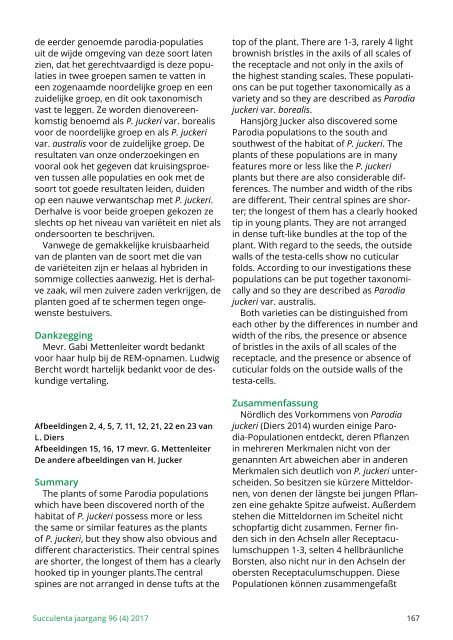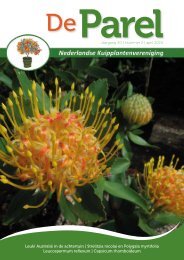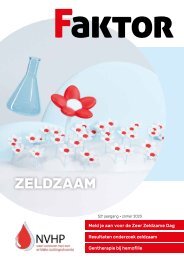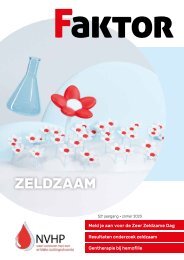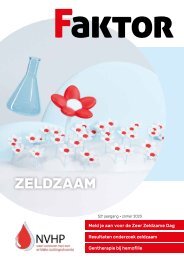You also want an ePaper? Increase the reach of your titles
YUMPU automatically turns print PDFs into web optimized ePapers that Google loves.
de eerder genoemde parodia-populaties<br />
uit de wijde omgeving van deze soort laten<br />
zien, dat het gerechtvaardigd is deze populaties<br />
in twee groepen samen te vatten in<br />
een zogenaamde noordelijke groep en een<br />
zuidelijke groep, en dit ook taxonomisch<br />
vast te leggen. Ze worden dienovereenkomstig<br />
benoemd als P. juckeri var. borealis<br />
voor de noordelijke groep en als P. juckeri<br />
var. australis voor de zuidelijke groep. De<br />
resultaten van onze onderzoekingen en<br />
vooral ook het gegeven dat kruisingsproeven<br />
tussen alle populaties en ook met de<br />
soort tot goede resultaten leiden, duiden<br />
op een nauwe verwantschap met P. juckeri.<br />
Derhalve is voor beide groepen gekozen ze<br />
slechts op het niveau van variëteit en niet als<br />
ondersoorten te beschrijven.<br />
Vanwege de gemakkelijke kruisbaarheid<br />
van de planten van de soort met die van<br />
de variëteiten zijn er helaas al hybriden in<br />
sommige collecties aanwezig. Het is derhalve<br />
zaak, wil men zuivere zaden verkrijgen, de<br />
planten goed af te schermen tegen ongewenste<br />
bestuivers.<br />
Dankzegging<br />
Mevr. Gabi Mettenleiter wordt bedankt<br />
voor haar hulp bij de REM-opnamen. Ludwig<br />
Bercht wordt hartelijk bedankt voor de deskundige<br />
vertaling.<br />
Afbeeldingen 2, 4, 5, 7, 11, 12, 21, 22 en 23 van<br />
L. Diers<br />
Afbeeldingen 15, 16, 17 mevr. G. Mettenleiter<br />
De andere afbeeldingen van H. Jucker<br />
Summary<br />
The plants of some Parodia populations<br />
which have been discovered north of the<br />
habitat of P. juckeri possess more or less<br />
the same or similar features as the plants<br />
of P. juckeri, but they show also obvious and<br />
different characteristics. Their central spines<br />
are shorter, the longest of them has a clearly<br />
hooked tip in younger plants.The central<br />
spines are not arranged in dense tufts at the<br />
top of the plant. There are 1-3, rarely 4 light<br />
brownish bristles in the axils of all scales of<br />
the receptacle and not only in the axils of<br />
the highest standing scales. These populations<br />
can be put together taxonomically as a<br />
variety and so they are described as Parodia<br />
juckeri var. borealis.<br />
Hansjörg Jucker also discovered some<br />
Parodia populations to the south and<br />
southwest of the habitat of P. juckeri. The<br />
plants of these populations are in many<br />
features more or less like the P. juckeri<br />
plants but there are also considerable differences.<br />
The number and width of the ribs<br />
are different. Their central spines are shorter;<br />
the longest of them has a clearly hooked<br />
tip in young plants. They are not arranged<br />
in dense tuft-like bundles at the top of the<br />
plant. With regard to the seeds, the outside<br />
walls of the testa-cells show no cuticular<br />
folds. According to our investigations these<br />
populations can be put together taxonomically<br />
and so they are described as Parodia<br />
juckeri var. australis.<br />
Both varieties can be distinguished from<br />
each other by the differences in number and<br />
width of the ribs, the presence or absence<br />
of bristles in the axils of all scales of the<br />
receptacle, and the presence or absence of<br />
cuticular folds on the outside walls of the<br />
testa-cells.<br />
Zusammenfassung<br />
Nördlich des Vorkommens von Parodia<br />
juckeri (Diers 2014) wurden einige Parodia-Populationen<br />
entdeckt, deren Pflanzen<br />
in mehreren Merkmalen nicht von der<br />
genannten Art abweichen aber in anderen<br />
Merkmalen sich deutlich von P. juckeri unterscheiden.<br />
So besitzen sie kürzere Mitteldornen,<br />
von denen der längste bei jungen Pflanzen<br />
eine gehakte Spitze aufweist. Außerdem<br />
stehen die Mitteldornen im Scheitel nicht<br />
schopfartig dicht zusammen. Ferner finden<br />
sich in den Achseln aller Receptaculumschuppen<br />
1-3, selten 4 hellbräunliche<br />
Borsten, also nicht nur in den Achseln der<br />
obersten Receptaculumschuppen. Diese<br />
Populationen können zusammengefaßt<br />
Succulenta jaargang 96 (4) <strong>2017</strong> 167


